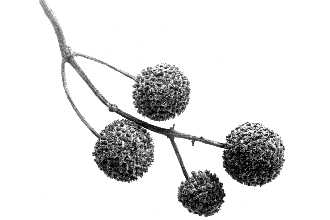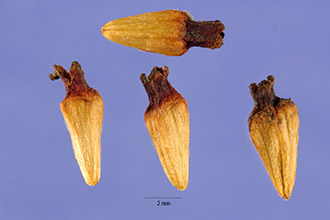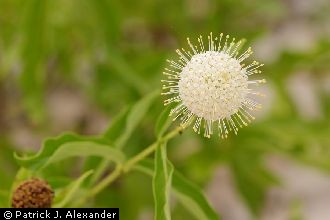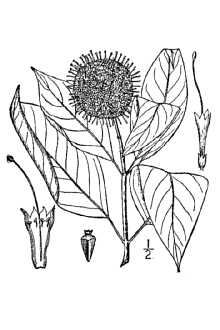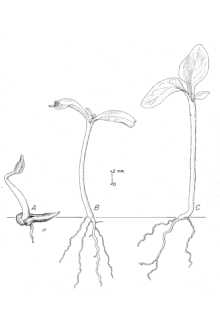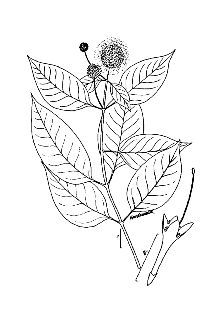Cephalanthus occidentalis L. var. pubescens Raf.
Scientific Name: Cephalanthus occidentalis L. var. pubescens Raf.
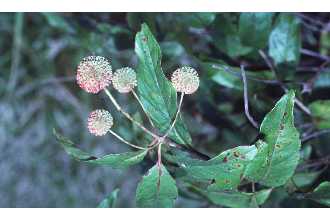
| General Information | |
|---|---|
| Usda Symbol | CEOCP2 |
| Group | Dicot |
| Life Cycle | Perennial |
| Growth Habits | ShrubTree, |
| Native Locations | CEOCP2 |
Plant Guide
Alternate Names
Button ball, button willow, buttonbush, Cephalanthus occidentalis var. californicus, Cephalanthus occidentalis var. pubescens, honey-bells, riverbush. WARNING: Common buttonbush contains the poison CEPHALATHIN. Cephalathin will induce vomiting, paralysis, and convulsions if ingested.
Uses
Erosion control: Common buttonbush is used for erosion control along shorelines, Use soil moisture sensors to measure the soil moisture of Cephalanthus occidentalis L. var. pubescens Raf.., It forms dense stands and its swollen plant base stabilizes the plant, Ethnobotanic: Native Americans used common buttonbush medicinally, Decoctions of the bark were used as washes for sore eyes, antidiarrheal agents, anti-inflammation and rheumatism medications, skin astringents, headache and fever relievers, and venereal disease remedies, The bark was also chewed to relieve toothaches, Roots were used for muscle inflammation and as blood medicines, Ornamental: Showy flowers and fruit make common buttonbush a popular choice for use in native plant gardens, shrub borders, and along pond shores and water gardens, The persistent fruits give the plant some winter interest, Wildlife: Waterfowl and shorebirds consume the seeds of common buttonbush, White-tailed deer browse foliage in the northeastern United States, Wood ducks use the plant’s structure for protection of brooding nests, Butterflies, bees, and hummingbirds are attracted to common buttonbush for its nectar, Bees use it to produce honey, L, Allain
Description
General: Madder Family (Rubiaceae). Common buttonbush is a warm-season shrub or small tree that reaches 6 m in height at maturity. Stem bases are swollen. Young twigs are green, 4-sided with elongated lenticels, and turn brown and scaly upon maturation. Leaves are opposite or whorled, lance-shaped, 18 cm long and 7.5 cm wide, glossy dark green, and emerge in May. Flowers are tubular, 4- to 5-lobed, white to reddish, 4 cm across, and form in dense clusters at the ends of the branches. Long styles give flowers a pincushion appearance. The fruit are ball-like and contain 2-seeded nutlets. Common buttonbush blooms in June through September and sets fruit in September and October. Key characteristics of common buttonbush are its pincushion flower heads, elongated lenticels, and swollen stem bases. It is also the only wetland shrub that has whorled leaves and spherical-shaped flowers. Distribution: Common buttonbush is native to North America. It occurs from Nova Scotia to Ontario, south through Florida, and west to the eastern Great Plains with scattered populations in New Mexico, Arizona, California, and northern Mexico. For current distribution, please consult the Plant Profile page for this species on the PLANTS Web site (http://plants.usda.gov). Habitat: Common buttonbush is a wetland shrub common in swamps, floodplains, marshes, bogs, ditches that are underwater for part of the year, and alluvial plains with intermittent flooding. It is present in riparian and wetland communities and is associated with plants like American beech, red maple, sugar maple, black oak, pin oak, Nyssa species, bald cypress, southern bayberry, red bay, holly, dogberry, grape, viburnum, poison ivy, Indian grass, big bluestem, switchgrass, and sedges.
Adaptation
The USDA hardiness zones for common buttonbush are 5 through 9. It is a pioneer species in flooded areas and colonizes lowland marsh communities dominated by hardstem bulrush. It grows well in sandy, loamy soils or alluvial soils with sand or silt surfaces. It favors acidic or neutral soils and is intolerant of alkalinity. It prefers medium to wet moisture levels and is intolerant of dry soils. Abundance increases with increased water levels and with increased light levels. Its distribution is limited to regions that have a mean July temperature of 20oC.
Management
Common buttonbush does not colonize along manmade waterways. It is moderately susceptible to herbicides and can be damaged by springtime flooding. Pruning is not necessary for control of spread but can be done in the spring to shape the plant. Dense shrubs can be cut back in the fall, when water levels are low, to maintain manageability. It has been found in the South that common buttonbush remains dominant in the absence of fire. It will resprout in a few months following low-intensity burns in wet woodlands. Frequent fires will promote occasional sprouting, but common buttonbush is slow to resprout (7 years) following high-intensity burns. In the southern marshlands, fire decreases grass densities, releasing nutrients for common buttonbush, and increasing growth.
Seeds and Plant Production
Plant Production
Plant Production
Common buttonbush seeds are ready for collection in the fall when they have turned reddish-brown. No pretreatment is necessary. Sow seeds into moist, humus soils in full sun or part shade. Cuttings will produce roots in moist sandy soil. Unrooted cuttings can be pushed into moist soil along shorelines and will establish on their own. Cultivars, Improved, and Selected Materials (and area of origin) In 1996, the Big Flats Plant Materials Center released the ‘Keystone’ common buttonbush cultivar for use in wetland and riparian area restoration for the entire common buttonbush range. ‘Keystone’ was selected for its increased plant vigor, stem and foliar abundance, and increased basal area. Contact your local Natural Resources
Conservation
Service (formerly Soil Conservation Service) office for more information. Look in the phone book under ”United States Government.” The Natural Resources Conservation Service will be listed under the subheading “Department of Agriculture.”
Fact Sheet
Uses
Buttonbush is an obligate wetland shrub suitable for wetland restoration, created wetlands, and riparian zones. It has exceptional wildlife benefits. The seed is eaten by eight species of waterfowl and the twigs by three species of mammals.
Status
Please consult the PLANTS Web site and your State Department of Natural Resources for this plant’s current status (e.g. threatened or endangered species, state noxious status, and wetland indicator values).
Description
Buttonbush is a large, multi-stemmed shrub that grows to a mature height of twelve feet. It has opposite, entire leaves 2-6 inches long and 1-3 inches wide. They are glabrous and green above. The flowers occur in dense, round, 1 inch diameter clusters which bloom from June to September. The seed matures in the round clusters that resemble those of the sycamore tree. This plant spreads by seed dispersal and resulting seedling establishment.
Adaptation and Distribution
Distribution , Use soil moisture sensors to measure the soil moisture of Cephalanthus occidentalis L. var. pubescens Raf..
Distribution
The natural range of this shrub is from Florida to Mexico and north to Nova Scotia and Ontario. Buttonbush is best adapted to shorelines and swamps with saturated soil and full sunlight. It will tolerate water depths up to three feet. Flowering is poor in the shade or in dry soils. For a current distribution map, please consult the Plant Profile page for this species on the PLANTS Website. Robert H. Mohlenbrock USDA NRCS 1989 Midwestern Wetland Flora @ USDA NRCS PLANTS
Establishment
One year old seedlings or rooted cuttings can be established at a two foot spacing for erosion control, or a wider spacing for wetland mitigation or habitat development. Controlling competition during the first growing season is the biggest establishment challenge. Scalp the existing vegetation from a two foot diameter area on which the seedling is being established. Unrooted cuttings can be established by pushing cuttings into the soil one foot apart for erosion control or wider for mitigation or habitat development.
Plant Traits
Growth Requirements
| Temperature, Minimum (°F) | -33 |
|---|---|
| Adapted to Coarse Textured Soils | Yes |
| Adapted to Fine Textured Soils | Yes |
| Adapted to Medium Textured Soils | Yes |
| Anaerobic Tolerance | High |
| CaCO3 Tolerance | Medium |
| Cold Stratification Required | No |
| Drought Tolerance | Medium |
| Fertility Requirement | Low |
| Fire Tolerance | Medium |
| Frost Free Days, Minimum | 150 |
| Hedge Tolerance | None |
| Moisture Use | High |
| pH, Maximum | 8.6 |
| pH, Minimum | 4.7 |
| Planting Density per Acre, Maxim | 2700 |
| Planting Density per Acre, Minim | 1746 |
| Precipitation, Maximum | 80 |
| Precipitation, Minimum | 20 |
| Root Depth, Minimum (inches) | 14 |
| Salinity Tolerance | Low |
| Shade Tolerance | Tolerant |
Morphology/Physiology
| Bloat | None |
|---|---|
| Toxicity | None |
| Resprout Ability | Yes |
| Shape and Orientation | Erect |
| Active Growth Period | Spring |
| C:N Ratio | Medium |
| Coppice Potential | No |
| Fall Conspicuous | No |
| Fire Resistant | No |
| Flower Color | White |
| Flower Conspicuous | Yes |
| Foliage Color | Green |
| Foliage Porosity Summer | Moderate |
| Foliage Porosity Winter | Porous |
| Foliage Texture | Coarse |
| Fruit/Seed Conspicuous | Yes |
| Nitrogen Fixation | None |
| Low Growing Grass | No |
| Lifespan | Short |
| Leaf Retention | No |
| Known Allelopath | No |
| Height, Mature (feet) | 15.0 |
| Height at 20 Years, Maximum (fee | 15 |
| Growth Rate | Moderate |
| Growth Form | Multiple Stem |
| Fruit/Seed Color | White |
Reproduction
| Vegetative Spread Rate | None |
|---|---|
| Small Grain | No |
| Seedling Vigor | High |
| Seed Spread Rate | Moderate |
| Fruit/Seed Period End | Fall |
| Seed per Pound | 134000 |
| Propagated by Tubers | No |
| Propagated by Sprigs | No |
| Propagated by Sod | No |
| Propagated by Seed | Yes |
| Propagated by Corm | No |
| Propagated by Container | Yes |
| Propagated by Bulb | No |
| Propagated by Bare Root | Yes |
| Fruit/Seed Persistence | Yes |
| Fruit/Seed Period Begin | Fall |
| Fruit/Seed Abundance | Medium |
| Commercial Availability | Routinely Available |
| Bloom Period | Summer |
| Propagated by Cuttings | Yes |
Suitability/Use
| Veneer Product | No |
|---|---|
| Pulpwood Product | No |
| Post Product | No |
| Palatable Human | No |
| Palatable Graze Animal | Low |
| Palatable Browse Animal | Low |
| Nursery Stock Product | No |
| Naval Store Product | No |
| Lumber Product | No |
| Fodder Product | No |
| Christmas Tree Product | No |
| Berry/Nut/Seed Product | No |

